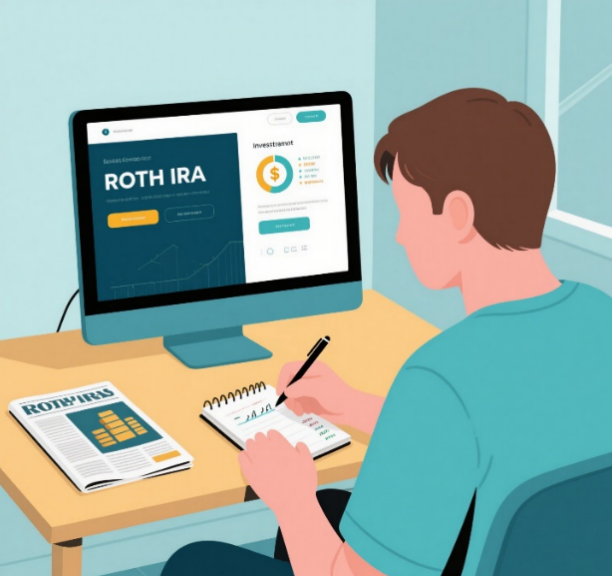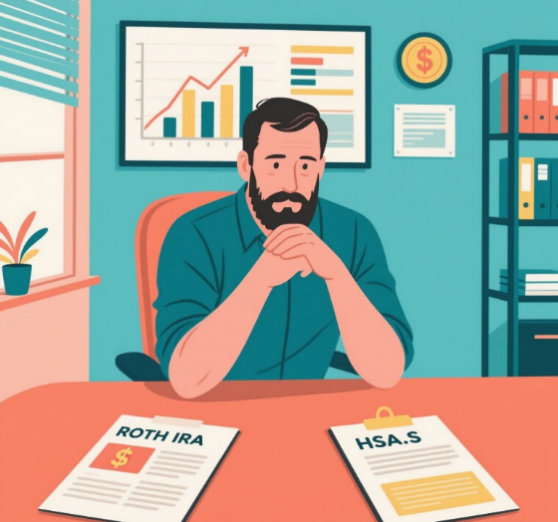
For individuals in their 20s to 40s, building a tax-efficient retirement strategy is crucial for long-term financial security. Two powerful tools—Roth IRAs and Health Savings Accounts (HSAs)—offer unique opportunities to grow wealth tax-free and maximize retirement income. This guide explores how to strategically use these accounts to secure a financially comfortable future.
Understanding Roth IRAs: The Tax-Free Retirement Foundation
A Roth IRA represents a retirement savings vehicle capitalized through post-tax contributions, meaning initial deposits do not qualify for immediate tax deductions; however, these funds generate tax-exempt growth and permit penalty-free, tax-free withdrawals during retirement. For the 2025 tax year, individuals with annual incomes up to $153,000 (filing single) or $228,000 (filing jointly as a married couple) are eligible to contribute up to $7,500 annually—with a $1,000 catch-up provision allowing those aged 50 and older to contribute $8,500. Its primary benefit stems from its favorable tax framework: in contrast to traditional IRAs, which subject withdrawals to income tax, Roth IRAs offer entirely tax-free growth and distributions, making them an optimal choice for individuals anticipating higher tax rates in their retirement years.
Strategies for Maximizing Roth IRAs
"Start Early to Harness Compounding Growth": Younger savers derive the utmost benefit from compound interest. An individual initiating monthly contributions of $600 ($7,200 annually) at age 25, assuming a 7% average annual return, stands to accumulate over $1.3 million by 65—all earnings growing and distributing entirely free of tax obligations.Convert Traditional IRAs to Roth Gradually: If you have a traditional IRA, consider partial conversions in low-income years to minimize tax burdens. This strategy is particularly effective during career transitions or periods of reduced income.
Use for Non-Retirement Goals (with Caution): While designed for retirement, Roth IRAs allow penalty-free withdrawals of contributions (not earnings) for first-time home purchases ($10,000 lifetime limit) or education, providing flexibility without tax consequences.

HSA: The Triple-Tax-Advantaged Account for Health and Retirement
HSAs complement Roth IRAs by offering triple tax benefits: contributions are tax-deductible (or made pre-tax through employers), earnings grow tax-free, and withdrawals for qualified medical expenses are tax-free. In contrast to flexible spending accounts (FSAs), HSAs are not subject to the "use-it-or-lose-it" provision, positioning them as robust long-term savings vehicles. For 2025, individuals with high-deductible health plans (HDHPs) can contribute up to 4,150(8,300 for families), with an additional $1,000 catch-up for those 55+.
Leveraging HSAs Beyond Healthcare
Build a Tax-Free Healthcare Nest Egg: Use HSA funds to pay for current medical costs or invest unused balances in stocks, bonds, or mutual funds (if your HSA provider offers investment options) to grow wealth tax-free.
Funding Healthcare in Retirement: Upon reaching 65, HSAs may be utilized for any purpose without incurring penalties, although withdrawals unrelated to medical expenses are subject to income taxation. However, using them for qualified medical expenses (including Medicare premiums and long-term care) keeps withdrawals tax-free, reducing retirement income tax exposure.
Combine with Insurance Strategies: Pair an HSA with a HDHP to lower monthly premiums, redirecting savings into the HSA for long-term growth. This proves particularly advantageous for individuals in robust health who do not anticipate frequent medical expenditures.
Synergizing Roth IRAs and HSAs for Maximum Impact
The real magic happens when using these accounts together:
Roth for General Retirement Income: Use Roth IRA withdrawals to cover non-medical expenses in retirement, ensuring tax-free cash flow for living costs, travel, or hobbies.
HSA for Healthcare Costs: Reserve HSA funds for medical needs, reducing the strain on other savings. This separation ensures both accounts' tax advantages are fully utilized.
Maximize Annual Contributions: Prioritize funding both accounts to their limits, especially if your employer offers HSA contributions. Modest annual contributions can accumulate substantially over decades owing to tax-free compounding.
Considerations for Your Age Group
Income Flexibility: In your 20s and 30s, income is often lower, making Roth IRA eligibility more accessible. As earnings rise, consider "backdoor Roth" strategies if income exceeds contribution limits.
Long Investment Horizon: HSAs and Roth IRAs thrive on time. The earlier you start, the more years your investments have to grow tax-free—a critical advantage for younger savers.
Inflation Protection: Tax-free growth helps offset inflation's impact on retirement savings, ensuring your purchasing power remains intact.

Conclusion: Start Your Tax-Efficient Journey Today
Roth IRAs and HSAs are not just savings accounts; they are strategic tools to build tax-free retirement income. By leveraging their unique benefits—Roth's tax-free distributions and HSA's triple tax advantages—you can create a robust financial foundation. Start small if needed, but start now. Every dollar contributed today, amplified by time and tax efficiency, brings you closer to a retirement where your income works for you, not the taxman.
Take the first step: review your eligibility, set up automatic contributions, and watch your tax-free nest egg grow. Your future self will thank you for this proactive financial planning.

Some insurance solutions for protected retirement income that you must know!

The Rise of Embedded Insurance :How Tech is Quietly Revolutionizing Coverage

The secret for insurance companies to improve user experience through solving four aspects of proble

Some key points that CROs in the insurance industry must pay attention to during the transformation

How Embedded Insurance is changing the Way We Buy Protection

Insurance and the Chinese Bagua Diagram: An Unlikely Yet Profound Connection

The Rise of Parametric Insurance: How Smart Contracts Are Simplifying Claims
